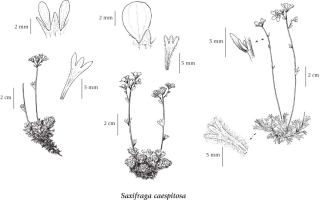Saxifraga cespitosa L.
tufted saxifrage
Saxifragaceae (Saxifrage family)
Introduction to Vascular Plants
tufted saxifrage
Saxifragaceae (Saxifrage family)
Introduction to Vascular Plants
Species Information click to expand contents
General:
Caespitose, perennial herb from branched stem-bases, often forming mats; numerous leafy branches, the flowering stems 3-15 cm tall, glandular-hairy.
Leaves:
Basal leaves usually 3-lobed, the lobes linear to lanceolate, narrowed to wide stalks, lightly glandular-fringed to soft-hairy, crowded on sterile shoots, 5-20 mm long; stem leaves 2 to 5, alternate, entire or lower ones lobed, reduced.
Flowers:
Inflorescence of terminal, 2- to 10-flowered, somewhat flat-topped clusters; petals creamy white, deciduous, egg-shaped to broadly wedge-shaped, 3.5-5.5 mm long, narrowed to a broad base or claw, the tips rounded, sometimes notched; calyces broadly bell-shaped, joined to ovary for about the same to 1/2 length of lobes, the free hypanthium absent, the calyx lobes 5, egg-shaped to oblong, 1-3 mm long, purplish, glandular-hairy, spreading; stamens 10.
Fruits:
Capsules, 5-10 mm long; seeds dark brown, egg-shaped, about 0.5 mm long, minutely pimpled.
Notes:
A highly variable species complex in which many taxa have been described. Since there is no satisfactory treatment of even the North American representatives the recognition of the supposed taxa that occur in BC would serve little purpose here. For an alternative treatment see C.L. Hitchcock et al. (1961) or Scoggan (1978).
Illustration click to expand contents

If more than one illustration is available for a species (e.g., separate illustrations were provided for two subspecies) then links to the separate images will be provided below. Note that individual subspecies or varietal illustrations are not always available.
Illustration Source: The Illustrated Flora of British Columbia
Ecology click to expand contents
Ecological Framework for Saxifraga cespitosa
The table below shows the species-specific information calculated from
original data (BEC database) provided by the BC Ministry of Forests and Range.
(Updated August, 2013)
The table below shows the species-specific information calculated from
original data (BEC database) provided by the BC Ministry of Forests and Range.
(Updated August, 2013)
| Site Information |
Value / Class |
||
|
Avg |
Min |
Max |
|
| Elevation
(metres) |
1729 | 7 | 2659 |
| Slope
Gradient (%) |
23 | 0 | 100 |
|
Aspect (degrees) |
250 | 0 | 360 |
| Soil
Moisture Regime (SMR) [0 - very xeric; 4 - mesic; 8 - hydric] |
2 | 1 | 8 |
| Modal
Nutrient Regime
Class |
C | ||
| #
of field plots species was recorded in: |
51 | ||
| Modal
BEC Zone Class |
BAFA | ||
|
All BEC Zones (# of stations/zone) species was recorded in |
AT(7), BAFA(24), CDF(1), cma(1), ESSF(8), IMA(4), SWB(1) | ||
|
Source:
Klinkenberg 2013
|
|||
Habitat and Range click to expand contents
Moist to dry, open gravelly areas, stream banks, cliffs, rocky slopes and ledges from the lowland to alpine zones; frequent throughout BC, except SC BC; circumpolar, N to AK and YT, E to NF and S to NM, AZ and CA; NE Eurasia.
Status Information click to expand contents
Synonyms click to expand contents
Synonyms and Alternate Names:
Saxifraga caespitosa L.